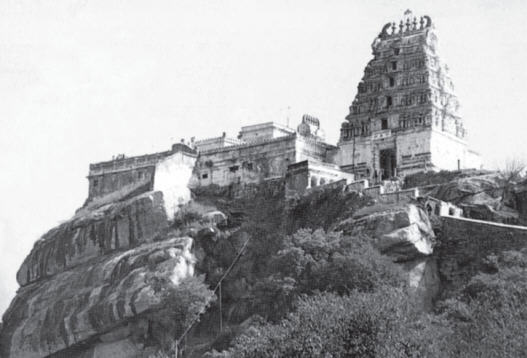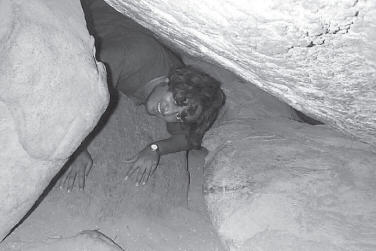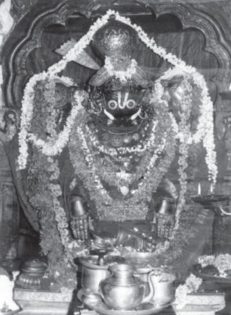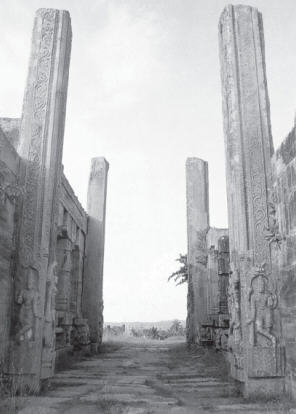This South Indian hill temple served as a refuge for many Vaisnavas during the Mogulera, including one of the greatest saints of Indian history.

Melukote Temple
Melukote sits on a hill about thirty miles north of Mysore, in the South Indian state of Karnataka. It is one of the four most important holy sites for Sri Vaisnavas. the followers of the great spiritual master and reformer Sri Ramanuja (A.D. 1017- 1137). Ramanuja spent at least twelve years in Melukote (may-Iu-ko-tay). setting up strict standards of deity worship still followed today.
The main temple in Melukote is that of Tiru Narayana. ("Tiru" is the Tamil equivalent of "Sri," an honorific meaning "opulent."}. Resting prominently on a hill above the town is the temple of Yoga Nrsimha, the Lord's half-man, half lion incarnation seated in a yoga posture.
I visited Melukote with my spiritual master, His Holiness Sridhara Swami, accompanied by three other ISKON members, including two from China.
In many South Indian temples, pilgrims who sponsor special worship of the deity are granted an exclusive viewing of the ceremony. Taking advantage of this custom, Rohini Tanai Dasa, a member of our group, arranged for Sridhara Swami to sponsor a bathing ceremony for Yoga Narasimha.
We arrived at the base of the hill at 11:00 A.M. and conquered countless steps to reach the entrance tower. After passing through several halls and corridors, we were greeted in the main temple h all by the chief priest, Narayana Bhatta. He had everything ready for the ceremony and began bathing the deity with water, milk, yogurt, honey, and sugarwater. Priests chanted prayers for purification from the Pavamana-sukta and prayers for glorification of the Lord from the Narayana Upanisad and the Visnu-suktas.
After the bathing, the doors to the deity's chamber were closed for five minutes. When they reopened, the deity in the dark room looked fearsome-He was covered with turmeric powder. A priest ended the ceremony by offering the deity some camphor, a ghee lamp, betel leaves, betel nuts, and a banana and then giving them to Sridhara Swami. This indicated that all the blessings were transferred to the person who sponsored the bathing of the deity.
At that point a priest allowed other people to have a glimpse of the Lord while we stayed in the inner sanctum of the deity room. Then the priest again closed the altar, humbly asking us to wait for some time until they finished dressing the Lord. They offered us caranamrta (water that had bathed the Lord) mixed with banana, jaggery (unrefined sugar), honey, coconut, and tulasrleaves.
While wa iting for the deity to be dressed, we went to the roof of the temple, from where we could see Melukote spread out below. The most prominent places we noticed were the Tiru Narayana temple, Kalyani ("Auspicious") Pond, the large entrance gate of a time- ravaged fort (Melukote means "upper fort"), and the Academy of Sanskrit Research, where computer scientists are working on, among other things, a program that can perform natural language processing with Sanskrit grammar. The Academy also has a well-stocked library of old manuscripts, a garden of purely Vedic plants, and livestock carefully bread to recapture the characteristics of early Vedic herds.
All the surrounding area was clearly visible from the hill. One of the priests told me that at night one can see the lights of Mysore.
PRAHLADA'S CAVE

Prahalad's Cave
The priest also told me that according to the Naradiya Purana , Prahlada Maharaja installed the deity of Yoga Nrsimha thousands of years ago while visiting Visnucitta, a celibate performing penance here. The priest invited us to see the cave under the temple where it's said that Prahlada Maharaja meditated. Some of us happily accepted the proposal and went down from the northern, back s ide of the temple. The entrance had narrow steps, and then we had to bend our heads and even crawl. The point where Prahlada Maharaja meditated is just below the deity. From there we crawled some more and then came out under the lower part of the temple.
By then the deity was dressed, so we went to see Him. One priest offered Him. 108 tulasi leaves while others chanted 108 names of Lord Nrsimha .
The temple was now open to all pilgrims, and they flooded in to see the Lord sitting in the yoga posture, dressed in red-and-white cloth, and wearing garlands of flowers and tulasi On His head rested a beautiful crown, and He wore metal gloves. Two of His hands rested on His folded knees, and the other two held a disc and a conch shell.
KALYANI POND
From the Yoga Nrsimha temple we came down the hill to meet a resident priest, Sudarsana Acarya. On the way to his house, we offered our respects to Kalyani Pond, the chief of several sacred ponds in Melukote, by sprinkling some of its water on our heads. According to the lsvara-sarhhita, when Lord Krsna in His incarnation as Lord Varaha lifted the earth from the universal ocean, some drops of water clinging to His body fell l on the hill at Melukote, creating Kalyani Pond. The Padma Purana mentions Kalyani Pond, and according to the Matya Purana, Garuda, Lord Visnu's eagle-carrier, brought white clay here from Svetadvipa, Lord Visnu's planet within this universe.
After passing through the main street, we arrived at the house of Sudarsana Acarya, where we stayed for two hours. He told us that the following great personalities had all visited Melukote: Lord Krsna, Lord Balarama, Lord Ramacandra, Lord Dattatreya, the Pandavas, Narada Muni, Sanat-kumara, Prahlada Maharaja, Ambarisa Maharaja, Parasara Muni, and Sri Ramanujacarya.
Sudarsana Acarya showed us his deities of Sudarsana (the Lord's disc) and Laksmi Nrsimha, given to his ancestors by Ramanujacarya, who had also authorized his ancestors to give mantras of Lord Nrsimha and Sudarsana for health and for protection in spiritual life.
After lunch at Sudarsana Acarya's home, we left for the daily 4:00-P.M. opening of the Tiru Narayana temple.
HISTORY

Yoga Nrshimha
It is said that Lord Narayana came to Melukote hill in response to a penance performed by Lord Brahma by which he assumed the form of a divine temple. Today the Tiru Narayana temple is not architecturally identical to the original one described in the Panca-ratragama, but it is st ill honored as a self manifested sacred place.
As we entered the temple, the deity Tiru Narayana was directly in front of us. He is five to six feet tall. Priests chanted 1,008 names of the Lord, who gave blessings with one hand and held a club, a disc, and a conch shell in His other three hands. Ramanujacarya discovered the deity in an' ant hill after the Lord directed him to the spot in a dream.
On the right side of the entrance, in a separate shrine, is a small Narayana deity, the processional deity, known as Cheluva Narayana, Cheluva Pillai, Sampad-kumara, and Ramapriya – one who is dear to Lord Rama." [See sidebar ''The Devotion of a Princess."] Lord Rama worshiped this deity with great love. In the Naradiya Purana, sages ask Narada Muni how Lord Narayana came to this place. He tells them that the deity was first presented to Brahma to worship, and Brahma gave the deity to Sanatkumara, one of his sons. Lord Visnu then ordered Ananta Sesa, the lord of the serpents, to assume the form of a mountain at Melukote and wait for His arrival. Sanat-kumara transported the deity with His entire temple complex to Melukote. Later he presented the deity to Lord Rama. Rama's son Kusa gave the deity as a dowry for his daughter, who married a prince of the Yadu dynasty.
Lord Krsna appeared in the Yadu dynasty and worshiped the deity. During that time, the diamond crown of the Lord Aniruddha (Visnu) , residing in the milk ocean, was stolen by Virocana, the son of Prahl ada. Garuda killed Virocana and retrieved the crown. But on the way back he found Krsna playing in Vrndavana with His friends and cows. So Garuda gave the crown, known as Vajramukti, to Lord Krsa, and Krsna offered it to the deity Ramapriya. (Today, Vairamudi-"The Festival of the Diamond Crown"is one of the temple's main festivals.)
When Lord Balarama returned to Dviiraka after one of His pilgrimages, He told Lord Krsna that the deity in Melukote (discove red by Ramanujacarya) was identical to their deity.
So they took Ramapriya to Melukote and placed Him before Tiru Narayana. They found no difference between them. Ramapriya stayed in Melukote, and thereafter the Yadus frequently visited there to worship the Lord, who became their fam ily deity.
HALL OF PILLARS

We offered prayers to the deity Ramapriya and then walked around the temple, stopping at the small shrines of Hanuman , Sri Laksmi, and the twelve Alvars, saints of the South Indian tradition. Sri Laksmi, the consort of Lord Narayana, is known here as Yadugiri Naciyar. Her grace is considered even more important than the Lord's. In front of her shrine is a hall of pillars carved with great dexterity. Each one is unique, filled with ornaments, dancing fig ures , and scenes from the Ramayana.
While examining the pillars, we arrived in front of the deity of Ramanujacharya, which was made during his lifetime and approved by him. When he had decided to leave Melukote, his disciples asked his permission to make the deity. Overwhelmed by their love and devotion, he consented.
During Ramanuja's twelve years in Melukote, a tyrant named Kullotunga Chola ruled southern India. He could not tolerate any worship of Lord Visnu. Many Vaisnavas fled to Melukote, where they were given refuge by the local people. Moved by the benevolence of the people of Melukote, Ramanuja called them Tirukulattar, "the kind people."
At that time in Karnataka, a Jain named Bittideva was ruler of Belur. He became a disciple of Ramanuja and received the Vaisnava name Visnuvardhana . As a service to his guru , he renovated the temple of Tiru Narayana.
In the late evening we left for Bangalore. I was inspired by the spirit of service to Vaisnavas shown in Melukote, and by the residents' surrender in devotion to the Lord, the same principles accepted and emphasized by Lord Caitanya Mahaprabhu.
Adbhuta Hari Dasa joined ISKCON in 1994 in Croatia. He served as a personal assistant to his spiritual master, Sridhara Swami.
